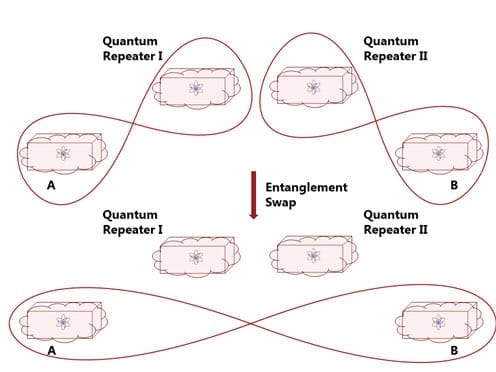
Possible “topological superconductor” could overcome industry’s problem of quantum decoherence.
A potentially useful material for building quantum computers has been unearthed at the National Institute of Standards and Technology (NIST), whose scientists have found a superconductor that could sidestep one of the primary obstacles standing in the way of effective quantum logic circuits.
Newly discovered properties in the compound uranium ditelluride, or UTe2, show that it could prove highly resistant to one of the nemeses of quantum computer development — the difficulty with making such a computer’s memory storage switches, called qubits, function long enough to finish a computation before losing the delicate physical relationship that allows them to operate as a group. This relationship, called quantum coherence, is hard to maintain because of disturbances from the surrounding world.
The compound’s unusual and strong resistance to magnetic fields makes it a rare bird among superconducting (SC) materials, which offer distinct advantages for qubit design, chiefly their resistance to the errors that can easily creep into quantum computation. UTe2’s exceptional behaviors could make it attractive to the nascent quantum computer industry, according to the research team’s Nick Butch.
“This is potentially the silicon of the quantum information age,” said Butch, a physicist at the NIST Center for Neutron Research (NCNR). “You could use uranium ditelluride to build the qubits of an efficient quantum computer.”
Research results from the team, which also includes scientists from the University of Maryland and Ames Laboratory, appear today in the journal Science. Their paper details UTe2’s uncommon properties, which are interesting from the perspectives of both technological application and fundamental science.
One of these is the unusual way the electrons that conduct electricity through UTe2 partner up. In copper wire or some other ordinary conductor, electrons travel as individual particles, but in all SCs they form what are called Cooper pairs. The electromagnetic interactions that cause these pairings are responsible for the material’s superconductivity. The explanation for this kind of superconductivity is named BCS theory after the three scientists who uncovered the pairings (and shared the Nobel Prize for doing so).
What’s specifically important to this Cooper pairing is a property that all electrons have. Known as quantum “spin,” it makes electrons behave as if they each have a little bar magnet running through them. In most SCs, the paired electrons have their quantum spins oriented in a single way — one electron’s points upward, while its partner points down. This opposed pairing is called a spin singlet.
A small number of known superconductors, though, are nonconformists, and UTe2 looks to be among them. Their Cooper pairs can have their spins oriented in one of three combinations, making them spin triplets. These combinations allow for the Cooper-pair spins to be oriented in parallel rather than in opposition. Most spin-triplet SCs are predicted to be “topological” SCs as well, with a highly useful property in which the superconductivity would occur on the surface of the material and would remain superconducting even in the face of external disturbances.
“These parallel spin pairs could help the computer remain functional,” Butch said. “It can’t spontaneously crash because of quantum fluctuations.”
All quantum computers up until this point have needed a way to correct the errors that creep in from their surroundings. SCs have long been understood to have general advantages as the basis for quantum computer components, and several recent commercial advances in quantum computer development have involved circuits made from superconductors. A topological SC’s properties — which a quantum computer might employ — would have the added advantage of not needing quantum error correction.
“We want a topological SC because it would give you error-free qubits. They could have very long lifetimes,” Butch said. “Topological SCs are an alternate route to quantum computing because they would protect the qubit from the environment.”
The team stumbled upon UTe2 while exploring uranium-based magnets, whose electronic properties can be tuned as desired by changing their chemistry, pressure or magnetic field — a useful feature to have when you want customizable materials. (None of these parameters are based on radioactivity. The material contains “depleted uranium,” which is only slightly radioactive. Qubits made from UTe2would be tiny, and they could easily be shielded from their environment by the rest of the computer.)
The team did not expect the compound to possess the properties they discovered.
“UTe2 had first been created back in the 1970s, and even fairly recent research articles described it as unremarkable,” Butch said. “We happened to make some UTe2 while we were synthesizing related materials, so we tested it at lower temperatures to see if perhaps some phenomenon might have been overlooked. We quickly realized that we had something very special on our hands.”
The NIST team started exploring UTe2 with specialized tools at both the NCNR and the University of Maryland. They saw that it became superconducting at low temperatures (below -271.5 degrees Celsius, or 1.6 kelvin). Its superconducting properties resembled those of rare superconductors that are also simultaneously ferromagnetic – acting like low-temperature permanent magnets. Yet, curiously, UTe2 is itself not ferromagnetic.
“That makes UTe2 fundamentally new for that reason alone,” Butch said.
It is also highly resistant to magnetic fields. Typically a field will destroy superconductivity, but depending on the direction in which the field is applied, UTe2 can withstand fields as high as 35 tesla. This is 3,500 times as strong as a typical refrigerator magnet, and many times more than most low-temperature topological SCs can endure.
While the team has not yet proved conclusively that UTe2 is a topological SC, Butch says this unusual resistance to strong magnetic fields means that it must be a spin-triplet SC, and therefore it is likely a topological SC as well. This resistance also might help scientists understand the nature of UTe2 and perhaps superconductivity itself.
“Exploring it further might give us insight into what stabilizes these parallel-spin SCs,” he said. “A major goal of SC research is to be able to understand superconductivity well enough that we know where to look for undiscovered SC materials. Right now we can’t do that. What about them is essential? We are hoping this material will tell us more.”
Learn more: Newfound Superconductor Material Could Be the ‘Silicon of Quantum Computers’
The Latest on: Quantum logic circuits
[google_news title=”” keyword=”quantum logic circuits” num_posts=”10″ blurb_length=”0″ show_thumb=”left”]
via Google News
The Latest on: Quantum logic circuits
- Nanofluidic memristors compute in brain-inspired logic circuitson April 22, 2024 at 7:29 am
Building artificial nanofluidic neural networks could provide a closer analogy to real neural systems, and could also be more energy-efficient. A memristor is a circuit element with a resistance (and ...
- Nanophotonic Circuits: Harnessing Light at the Nanoscaleon April 11, 2024 at 7:17 am
Nanophotonic circuits can be used to perform optical information processing functions, such as logic operations ... Moreover, the exploration of quantum photonic circuits, where nanophotonic devices ...
- Quantum computers can solve combinatorial optimization problems more easily than conventional methods, research showson March 18, 2024 at 2:09 pm
Quantum computers use so-called qubits, which are not either zero or one as in conventional logic circuits, but can take on any value in between. These qubits are realized by highly cooled atoms ...
- Photonic quantum technologieson February 19, 2024 at 6:30 am
There are two significant challenges for quantum optical circuits. First is that imperfections in the processes used for single-photon generation degrade quantum interference of two or more photons.
- Mastering the quantum code: A primer on quantum softwareon January 28, 2024 at 4:00 pm
From turning abstract quantum algorithms into executable code to optimizing circuit designs ... computer necessitates a new approach, new logic, and an entirely new set of programming languages.
- Logic and Algebraic Structures in Quantum Computingon January 10, 2024 at 3:16 am
Themes range from philosophical examination of the foundations of physics and quantum logic, to exploitations of the methods and structures of operator theory, category theory, and knot theory in an ...
- CMOS Technology Explainedon April 29, 2023 at 7:36 am
This enables quantum computers to solve problems that are intractable ... static RAM, and other digital logic circuits. It uses both PMOS and NMOS transistors to create logic functions. CMOS ...
- Quantum Tunneling Mechanism in NeoFuseon January 13, 2021 at 2:09 am
NeoFuse is a logic-process compatible non-volatile memory (logic-NVM ... user-friendly interface and fully integrated OTP IP that minimizes design effort and circuit complexity. The NeoFuse OTP IP can ...
- Enlightened chipson April 17, 2015 at 9:01 am
But the actual performance numbers show there is still a way to go before we have at hand chips with optical circuits that contain several tens of quantum logic gates. Luckily, this first ...
- Ultra Low Power Logic Design with Quantum Cellson November 25, 2012 at 5:16 am
Logic Design with Quantum Dots is one of the most recent technologies being ... information from inputs to the output by modifying the cell tunneling energy.QCA circuits have a four phase clock as ...
via Bing News










